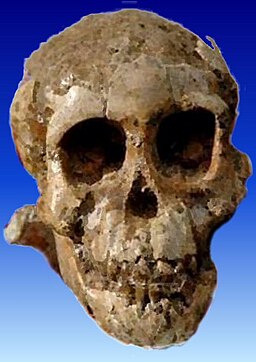
Selam or DIK-1/1 is the fossilized skull and other skeletal remains of a three-year-old Australopithecus afarensis female hominin, whose bones were first found in Dikika, Ethiopia in 2000.
Also nicknamed Lucy’s baby, the specimen has been dated at 3.3 million years ago, approximately 120,000 years older than “Lucy” dated to about 3.18 mya.
The fossils are remarkable for their age plus the dig in Dikika, Ethiopia, is only a few miles south of Hadar, the well-known site where the fossil hominin known as Lucy was found.
The features of this skeleton suggest adaptation to walking upright as well as tree-climbing, features that correspond well with the skeletal elements of Lucy and other specimens of Australopithecus afarensis from Ethiopia and Tanzania.
Selam (Australopithecus)
- Title: Selam (Australopithecus)
- Dated to: 3.3 million years ago
- Discovered: Dikika, Afar Depression, Ethiopia
- Date discovered: 2000
- Museum: National Museum of Ethiopia
- City: Addis Ababa
Fossils of mummy Selam reveals how children lived 3 million years ago!
A Tour of the National Museum of Ethiopia
- Throne of Emperor Haile Selassie
- Ethiopian Crown
- Selam (Australopithecus)
- Lucy (Australopithecus)
Selam Australopithecus afarensis
A Tour of African Museums
- Egypt
- Egyptian Museum
- South Africa
- Cape Town
- Iziko South African National Gallery
- Cape Town
- Ethiopia
- Addis Ababa
- National Museum of Ethiopia
- Addis Ababa
The Earliest Child The Significance of “Selam”
~~~
“He who knows much does not speak much.”
– Ethiopian Proverb
~~~
Photo Credits: 1) By Jlorenz1 (Own work) [GFDL (gnu.org/copyleft/fdl.html) or CC BY-SA 3.0 (creativecommons.org/licenses/by-sa/3.0)], via Wikimedia Commons | Content sourced from Wikipedia,
Popular this Week








 Sponsor your Favorite Page
Sponsor your Favorite Page SEARCH Search for: Search Follow UsJoin – The JOM Membership Program
Sponsor a Masterpiece with YOUR NAME CHOICE for $5
Share this:
- Tweet
